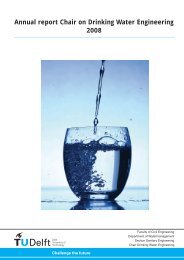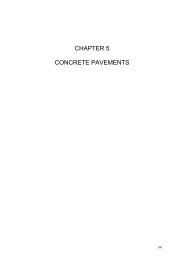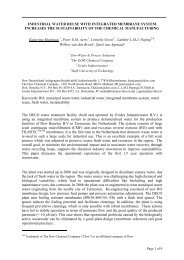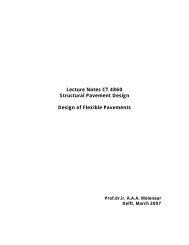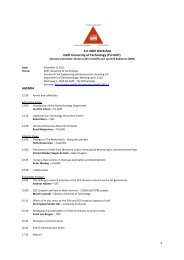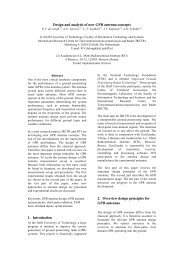CT4860 STRUCTURAL DESIGN OF PAVEMENTS
CT4860 STRUCTURAL DESIGN OF PAVEMENTS
CT4860 STRUCTURAL DESIGN OF PAVEMENTS
You also want an ePaper? Increase the reach of your titles
YUMPU automatically turns print PDFs into web optimized ePapers that Google loves.
3.4 Stresses and displacements due to traffic loadings<br />
3.4.1 Introduction<br />
In 1926 Westergaard published his original equations for the calculation of the<br />
maximum flexural tensile stress and the maximum vertical displacement due<br />
to a single wheel load in the interior, at the edge or at the corner of a single<br />
concrete slab. In latter years Westergaard himself as well as other<br />
researchers published several ‘modified’ Westergaard-equations. Until today<br />
this Westergaard-theory is widely used all over the world to calculate the<br />
stresses and displacements in concrete pavement structures due to traffic<br />
loadings. The Westergaard-theory is described in 3.4.2.<br />
In reality a concrete pavement structure does not exist of a single concrete<br />
slab, but of a number of concrete slabs with longitudinal and transverse joints<br />
(plain concrete pavements) or longitudinal joints and transverse cracks<br />
(reinforced concrete pavements). The load transfer in these joints and cracks,<br />
and the consequences for the stresses and displacements of the concrete<br />
pavement structure, are discussed in 3.4.3.<br />
3.4.2 Single concrete slab (Westergaard-theory)<br />
Westergaard developed a theory for the maximum stress (flexural tensile<br />
stress) and the maximum vertical displacement (deflection) due to a single<br />
wheel load, located in the interior (middle), along the edge or in a corner of a<br />
single (concrete) slab on an elastic foundation (springs with a stiffness equal<br />
to the modulus of substructure reaction k).<br />
The fully supported slab is assumed to be such large, that the edges and<br />
corners don’t have any significant influence on the maximum stress and<br />
deflection.<br />
In the cases that the single wheel load is in the interior or along the edge or<br />
crack of the concrete slab, both the flexural tensile stress and deflection are<br />
maximum at the bottom of the concrete slab in the load centre. In case of a<br />
single wheel load in the corner of the slab, the deflection is maximum exactly<br />
in the corner while the flexural tensile stress is maximum at some distance of<br />
the corner at the top of the concrete slab (figure 13).<br />
Figure 13. Loading positions in Westergaard’s theory.<br />
32



